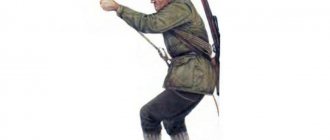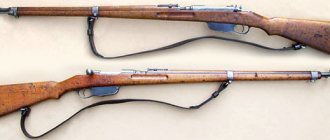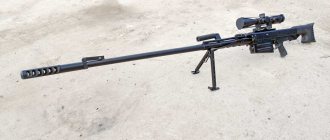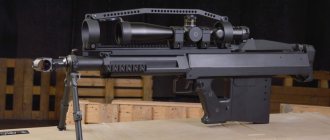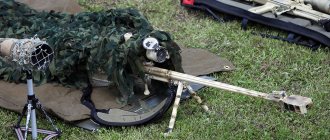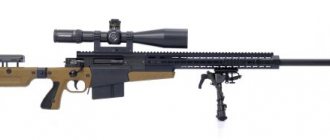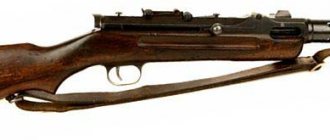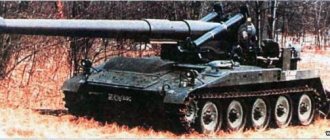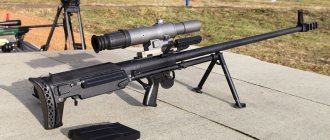Anti-material rifle
| This article requires additional links for verification . |
Type of single-shot bolt-action anti-material rifle
| IWS 2000 | |
| Steyr IWS 2000, left view | |
| Type | Single-shot bolt-action anti-material rifle |
| Place of origin | Austria |
| Production history | |
| Developed | Mid 1980s |
| Manufacturer | Steyr Mannlicher |
| Options | IWS 2000 AMR 5075 |
| Characteristics | |
| Weight | 18 kg (39.7 lb) |
| Length | 1800 mm (70.9 in) |
| Barrel length | 1200 mm (47.2 in) |
| Cartridge | 15.2 × 169 mm (IWS 2000 and AMR 5075) |
| Cartridge weight | 150 g (5.3 oz) |
| Action | Long-Recoil Single Action Bolt Rotating Bolt |
| starting speed | 1450 meters per second (4757 feet per second) |
| Effective firing range | 1000 meters (1093 yards) |
| Maximum firing range | 2,500 meters (2,734 yards) |
| Feeding system | Single shot, no magazine |
| Attractions | 10x optical sight |
Steyr IWS 2000
is an Austrian single-shot bolt-action anti-material rifle manufactured by Steyr Mannlicher. IWS stands for Infantry Weapon System. Like many modern anti-tank guns, as well as tank guns, it is actually a smoothbore weapon and not a true rifle. This can help speed up projectiles and improve ballistic efficiency, but the lack of rifling to impart inertial stability requires the projectile to have stabilizing fins. It is the first man-portable rifle to use this type of ammunition, firing an armor-piercing fin with a 15.2×169mm (207mm length) fin.
The first weapon option was the proposed AMR 5075
(AMR - Anti-Material Rifle). It was to fire the same type of ammunition as the IWS 2000 and use a 5-round detachable box magazine. However, this version did not make it past the proposal stage.
Mechanism[edit]
The weapon is based on a 25 cm (9 3/4 in) long recoil mechanism. This mechanism, commonly found in shotguns, helps manage the high recoil force of the 15.2mm Steyr APFSDS round due to its damping effect, which allows the force to be distributed over a longer period of time. Another unusual feature of this weapon is the movement of the barrel. Once fired, the barrel rolls into a shock-absorbing hydropneumatic sleeve, much like that found on the LG 1 Mark II 105 mm howitzer. The IWS 2000 also uses a multi-baffle muzzle brake to distribute muzzle energy and further reduce recoil, similar to that used on the D-30 2A18M 122mm towed howitzer. The entire body of the rifle is made from a combination of high-strength plastic and ultra-lightweight polymers for improved handling and weight loss. The smoothbore barrel is easy to remove and stow for greater mobility. The APFSDS cartridge is inserted from the side, as in conventional single-shot rifles.
Sniper "guns" Steyr AMR and IWS 2000
In the 80s of the last century, many well-known firearms manufacturers began to “play” with sub-caliber ammunition; many well-known arms companies continue to work on the cartridge itself and weapons for it, feeling that the near future will be assigned to such weapons. Already now we can identify many samples that can undoubtedly be called successful, but they are not yet going into mass production due to banal financial difficulties among potential customers, because such weapons, or rather the cartridges for them, are not very cheap. Apparently, the armies and law enforcement officers of the countries of the world have not yet matured to give more than the usual amount for each shot.
Among the albeit small, but already impressive number of weapon models that use sub-caliber ammunition, it is worth highlighting sniper rifles. After all, if the transition to a new type of ammunition is carried out, it will be with these samples due to their higher efficiency in comparison with models that are similar in parameters, using classic ammunition. After all, no matter what the cost of the cartridge, it is in the work of a sniper that it more than pays off. So one of the examples of such weapons is the brainchild of the Austrian company Steyr, positioned by the manufacturer as a large-caliber sniper rifle or, as it has now become fashionable to say, an “anti-material” rifle.
Work on the creation of a new ammunition and weapons for it began in 1984, then, at the initial stage, experiments were carried out with 12.7 mm caliber ammunition. The plan was to create a cartridge that could be used in ordinary weapons, but nothing came of it. 12.7 millimeters was not enough to accommodate a feathered projectile, which would surpass the classically designed ammunition in its characteristics. Having abandoned a rather successful idea, had it been implemented, to create a cartridge with a sub-caliber projectile based on the 12.7x99 cartridge, the designers began to increase the caliber of the ammunition. The first version of the cartridge with more or less successful characteristics was 14.5 millimeters in caliber; several rifles were produced under it, designated AMR 5075.
This cartridge was a rather interesting design, which naturally affected the price of the ammunition. So the most interesting point is that the ignition of the powder charge does not occur at the bottom of the cartridge case, but in the center, which leads to faster combustion of the gunpowder, and, accordingly, to a faster build-up of pressure of the powder gases, and the speed of the projectile increases accordingly. The bullet itself, if you can call it that, is a split plastic shell into which a tungsten alloy arrow is clamped. The most difficult thing for the developers was to create a plastic shell design that would have absolutely no effect on the trajectory of the arrow itself during separation from it. And I must say they succeeded. Literally a few meters from the muzzle, the projectile loses its plastic casing under the influence of increasing air resistance, after which the tungsten alloy arrow continues further movement at almost the same speed. At the same time, the arrow itself, being feathered, is stabilized in flight and is significantly less influenced by factors such as side wind and others. However, one should take into account the light weight of the arrow itself, due to which the effective range was very short compared to the more common .50BMG. However, for the experimental model, even those 800 meters of effective range that the AMR 5075 rifle showed were quite a good result. It should also be understood that the effective range in this case was calculated not exactly in the same way as for conventional weapons, but with the condition of confidently penetrating armor. Another feature of this cartridge is that the ammunition casing is plastic, despite the fairly large powder charge, only the bottom of the casing is metal. This made it possible to significantly reduce the weight of the ammunition, and the cost obviously did not become higher, although it still remained high.
Probably, many people paid attention to the title of the article, in which the weapon is called a “sniper gun”; despite the absurdity of this expression, it is completely true. The fact is that the barrel of the weapon is completely smooth, therefore, despite the high accuracy and range of use, it cannot be called a rifle, but let’s not get into the jungle of terminology. The first version of the rifle was actually not entirely successful. The first of its negative qualities was the very high recoil when firing, which was partially compensated by the muzzle brake-compensator and partially by the automatic weapon itself, but was not compensated enough. The automatic rifle is built according to a design with a long barrel stroke, which is not so often seen. When fired, the powder gases not only try to push the bullet out of the barrel, but also put pressure on the bottom of the cartridge case with the same force. However, the latter is sandwiched between the barrel and the bolt, which prevents it from leaving the chamber freely. As a result, the barrel and bolt of the weapon begin to move backward together. In the last centimeters of the path, the bolt begins to turn and disengages from the barrel, after which the bolt is fixed in the rear position, and the barrel begins to move forward, during which the spent cartridge case is removed. Having reached its extreme forward point, the barrel of the weapon releases the bolt, which immediately begins to move towards the barrel, removing a new cartridge from the magazine and inserting it into the chamber. At the same time, in the last centimeters of its path, the bolt turns back, locking the barrel. The weapon is then ready for the next shot. All this disgrace is assembled in a bullpup layout, with the widest use of plastic to reduce weight and has three bipods. It should be noted that in addition to the very high recoil when firing from this model, the designers were not satisfied with the results of the effective range of the shot; for this reason, work on the project continued and resulted not only in the modernization of the weapon itself, but also in the modernization of the ammunition that is used in it. In general, this was the last experimental sample, followed by the final finished product, completely ready for mass production.
As mentioned above, this weapon is intended primarily to destroy enemy lightly armored vehicles, parked aircraft, radars and the destruction of unexploded shells, and this is what limits the effective range of the weapon. In order to increase the effective range, it was decided to increase the weight of the tungsten arrow, which in turn led to an increase in the caliber of the cartridge. In general, there were no complaints about the design of the ammunition; for this reason, we limited ourselves to only enlarging the cartridge itself. After modernization, its caliber became 15.2 millimeters, and the already large powder charge became even larger. The increase in the caliber and power of the ammunition was not in vain; the effective range of use of the weapon was already 1000 meters, and at this distance the arrow penetrated 40 millimeters of homogeneous armor, which is a fairly impressive indicator. Although this weapon is not intended for firing at living targets, as evidenced by the rather short effective range of the weapon, no one prohibits such fire. At the same time, the effective range of the weapon increases by another one and a half kilometers, which puts virtually all modern large-caliber rifles in the belt. You should also not forget that the design of the arrow is such that if it hits even a target protected by personal protective equipment, death is guaranteed. However, not every sniper can guarantee a hit at such distances, even with such a rifle.
The final parameters of the ammunition used in the weapon are as follows. The weight of the feathered arrow is from 20 to 30 grams, its caliber is 5.5 millimeters, the speed of movement at the muzzle is 1450 meters per second. It is also worth noting that when shooting at 1000, the arrow itself decreases from the aiming point by only 80 centimeters, and the high speed of the bullet makes shooting at moving targets more comfortable.
Naturally, the modernized ammunition also required a new weapon that would solve the problem of fairly high recoil. The final version of the “sniper gun” was named IWS 2000, with which it entered the arms market. In general, this model did not differ much from the previous experimental one. Still the same maximum amount of plastic to reduce weight, still the same layout, still the same automatic operation scheme. Of the changes, only a pneumohydraulic shock absorber was added, which is located around the barrel and, in fact, is the connecting link between the receiver and the barrel of the weapon. Its presence made it possible to significantly extend the moment of recoil and, despite the increased power of the ammunition, make it quite comfortable. It is worth noting separately that this did not affect the accuracy of the weapon in any way.
In general, it should be noted that, despite the apparent angularity and dimensions, the weapon turned out to be quite convenient both during operation and during maintenance. Separately, it is worth noting the rifle’s magazine, which is very conveniently located on the right side of the weapon at an angle of 45 degrees relative to the earth’s surface. The third “leg” is also quite a nice addition, especially in situations where you have to monitor the territory for a long time. However, in terms of weight and dimensions, despite all the efforts of the designers, this weapon remains quite massive and heavy, losing even to the more common rifles chambered for .50BMG. So the weight of the rifle without ammunition is 18 kilograms, and the length is 180 centimeters, with a barrel length of 1200 millimeters. Thus, in terms of its weight and dimensions, this rifle is closer to twenty-millimeter large-caliber sniper rifles. In order to compensate for this shortcoming, the designers made it possible to divide the weapon into two parts, which are packed into two shoulder bags and carried by the sniper crew. The weapon is standardly equipped with a tenfold optical sight, but it can be replaced with one more suitable for the situation or convenient for the shooter.
If you look at this weapon as a ready-made model, then you cannot help but note such a disadvantage as the presence of an air-oil shock absorber for the barrel. In general, it does not cause any complaints, but the fact that this particular element will behave capriciously at high or low temperatures leaves no doubt. Perhaps this problem can be solved by replacing the oil with a different type of oil, but the manufacturer is silent about this, and this procedure is unlikely to be simple, given that the pressures inside the shock absorber during firing are quite high.
In general, this sniper rifle-gun back in 1998 was a final product, completely ready for launch into mass production. However, until now this weapon has not received even minimal distribution. The reason for this is naturally in the ammunition; after all, adopting only weapons is one thing, but when we also talk about ammunition for them, then completely different numbers appear here. Naturally, people became interested in this model of rifle and ordered it in small quantities, however, like any self-respecting company, Steyr does not disseminate information about what and who bought it. All that is known for certain is that the US Army purchased several IWS 2000, which even managed to appear in recent military operations, but there is no talk of officially adopting these weapons into service. Still, as a pleasure, such weapons remain expensive even for those armies that receive stable and substantial funding, regardless of the economic situation.
Ammunition[edit]
The round is a 15.2mm drop-type projectile with fins and armor-piercing capability that the IWS 2000 was specifically designed for firing only. It contains a dart-shaped penetrator of either tungsten carbide or depleted uranium, capable of piercing 40 mm [1] of rolled homogeneous armor at a range of 1000 m, and causing secondary fragmentation. The cartridge consists of a plastic body, a steel head and a plastic casing-shoe around the penetrator.
